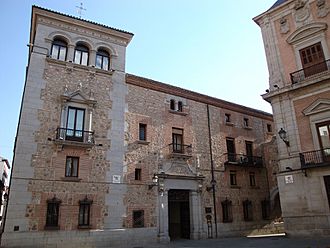Casa de Cisneros (Madrid) facts for kids
Quick facts for kids Casa de Cisneros |
|
|---|---|

La Casa de Cisneros in the Plaza de Villa.
|
|
| General information | |
| Type | Palace |
| Architectural style | Plateresque |
| Address | Plaza de la Villa |
| Town or city | Madrid |
| Country | Spain |
| Opened | 1537 |
| Renovated | 1909 |
| Design and construction | |
| Architect | Benito Jiménez de Cisneros |
The Casa de Cisneros is a historic palace in Madrid, Spain. It stands in the famous Plaza de la Villa. This beautiful building was finished in 1537.
It was built for Benito Jiménez de Cisneros. He was an architect in the 1500s. Benito was also the nephew of Cardinal Cisneros. The Cardinal was a very important church leader and advisor. He also started the Complutense University. The palace is named in honor of this important family.
Contents
What Makes the Casa de Cisneros Special?
The Casa de Cisneros is built in the Plateresque style. This is a special Spanish architectural style. It mixes elements from the Renaissance with traditional Spanish designs. It often looks like silversmiths' work, which is where its name comes from.
Plaza de la Villa Facade
The side of the palace facing the Plaza de la Villa was updated around 1909. The city of Madrid bought the building then. They connected it to the old town hall, the Casa de la Villa.
The architect Antonio Bellido y Gonzánlez led this renovation. He made sure the changes matched the original design. He also added a secret passage. This passage connects the Casa de Cisneros to the old town hall building.
Sacramento Street Facade
The facade on Calle Sacramento was once the main entrance. It has a lot of history and artistic value. Even though it was changed a bit in 1909, it remains very important.
Many stories are told about this palace. One story says that Antonio Pérez was held here. He was a royal secretary to King Philip II of Spain. The palace is also the birthplace of Álvaro de Figueroa, 1st Count of Romanones. He was an important Spanish politician. General Ramón María Narváez, 1st Duke of Valencia also lived here in 1868.
See also
 In Spanish: Casa de Cisneros para niños
In Spanish: Casa de Cisneros para niños
- Madrid The main article about the modern capital city of Spain
- El Madrid de los Austrias
- Madrid capital

